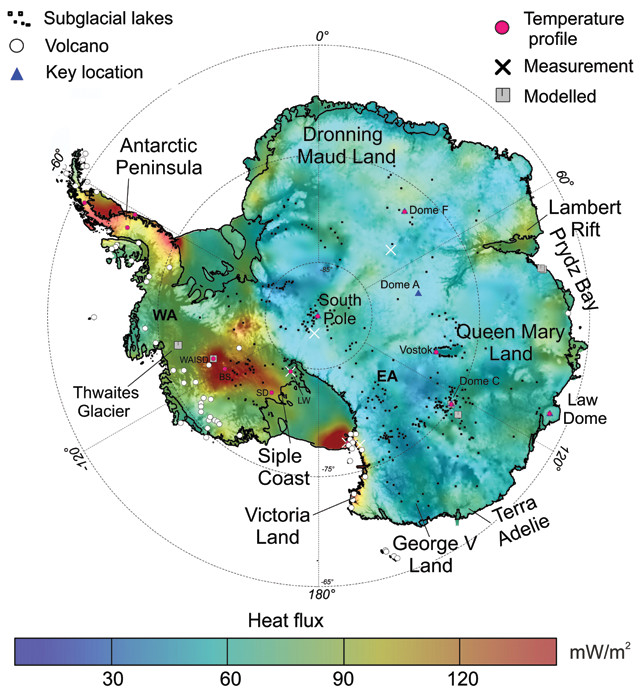
by Timothy Oleson Tuesday, February 27, 2018

A new map shows the geothermal heat flux beneath Antarctica in detail. Credit: Martos et al., Geophysical Research Letters, November 2017.
From Antarctica to the Arctic; from polar caps, permafrost and glaciers to ocean-rafted sea ice; and from burly bears to cold-loving microbes, fascinating science is found in every nook and crevasse of Earth’s cryosphere, and new findings are announced often. Here are a few of the latest updates.
Scientists have produced the highest-resolution map yet of geothermal heat flux beneath Antarctica. Geothermal heat in the crust provides a fundamental control on the shape and flow of the overlying Antarctic Ice Sheet. Researchers derived heat-flux estimates from magnetic data collected during airborne surveys, finding hot spots along the Antarctic Peninsula and the West Antarctic Rift System as well as greater spatial variability in East Antarctica than has previously been recognized. “Small-scale spatial variability and features consistent with known geology are better reproduced [in the new map] than in previous models” by 36 to 50 percent, the researchers wrote in Geophysical Research Letters. “If we are to predict with any certainty the future response of Antarctica in a warming world, scientists need to understand the role that heat from the Earth plays,” said David Vaughan, director of science at the British Antarctic Survey and a co-author of the study, in a statement. “That’s why this new map is so important.”
More than 100 glaciers flow from the Greenland Ice Sheet into the surrounding ocean via fjords, and the depths and shapes of these fjords influence how quickly the glacial ice melts. For instance, ridges or bumps on fjord floors can slow the movement of grounded glaciers. Additionally, around Greenland, seawater at depths below 200 to 300 meters — which arrives from the Atlantic Ocean — is a few degrees warmer on average than the water above (sourced largely from melting Arctic ice), so glaciers sitting in deeper fjords are vulnerable to increased melting. Recent research on a limited number of Greenland’s fjords has shown that some are deeper than previously thought, potentially explaining the faster retreat of the ice fronts in those fjords. But a detailed, whole-island view has been lacking due to the limited availability and low resolution of bathymetry data around Greenland. In a new study in Geophysical Research Letters, a team led by Mathieu Morlighem of the University of California, Irvine, compiled recent bathymetric data from 30 international sources to produce a comprehensive, high-resolution map of seafloor and fjord bathymetry around Greenland. The team found that many fjords are indeed deeper than recognized and concluded that between 30 and 100 percent more of Greenland’s marine-terminating glaciers are potentially exposed to relatively warm Atlantic waters than previously estimated.
Antarctic krill, tiny crustaceans that feed on plankton, are themselves a vital food source for an array of marine animals, including whales, seals, penguins and fish. Much remains unknown about krill ecology, however, including where they source most of their food in different seasons. In a new study in Nature Ecology and Evolution, researchers suggest an update to a prevailing idea about the winter habitat of Antarctic krill larvae. To mature into adults and help maintain populations, larval krill must find enough food to survive through winter. It’s been thought that algae melting out of sea ice in the broad area of pack ice around Antarctica serve as a main food source for larval krill, but recent work has suggested these algae may not be adequate. Based on measurements and divers’ direct observations of krill larvae numbers and habits during a 2013 austral winter research cruise, Bettina Meyer of the Alfred Wegener Institute in Germany and colleagues found that the creatures prefer habitats near the edge of the winter sea-ice extent rather than under the pack ice. They observed that, during the daytime, krill larvae congregate under ice floes, in notches that offer protection from predators and where the small amount of algae melting out of the sea ice naturally collects. After sunset, however, they emerge from these hiding spots and swim toward open waters to feed on plankton whose growth is spurred by exposure to daytime sunlight. As sunrise comes, they return to their sub-ice habitats. The researchers wrote that, for krill larvae, “this behavior increases both food uptake … and the likelihood of overwinter transport to areas where feeding conditions are more favorable in spring.”
© 2008-2021. All rights reserved. Any copying, redistribution or retransmission of any of the contents of this service without the expressed written permission of the American Geosciences Institute is expressly prohibited. Click here for all copyright requests.